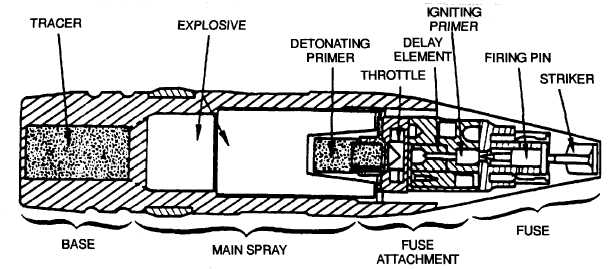TM 1-1520240-BD
SECTION III. COMBAT THREATS
1-10. THREAT DESCRIPTION . The primary threats
confronting Army helicopters in combat include the
armor-piercing (AP) and armor-piercing-incendiary (API)
projectiles,
the
high-explosive-incendiary
(HEI)
projectiles, and several types of ground-to-air and air-to-
air missiles. Nuclear, biological, and chemical (NBC)
warfare
also
poses
a
threat
to
the
successful
accomplishment of the aviation mission. In addition to
the threats helicopters may encounter in flight, they will
be exposed to damage by bombs, mortars, and artillery
while on the ground.
1-11. ARMOR-PIERCING
AND
ARMOR-PIERCING
INCENDIARY PROJECTILES. AP and API projectiles
will cause most of the damage. These projectiles
consist of a hard tough core, designed for maximum
penetration The API projectile also has a thermally
active filler. The active filler is located in front of the
passive core. Upon impact, the core penetrates the
outside of the target. This gives the projectile a fire-
starting capability if flammable materials are present.
a.
Armor-Piercing Projectile. The damage caused
by an armor-piercing projectile depends on its mass,
velocity, and angle at impact. The primary damage is
caused by the penetrator.
b.
Armor-Piercing-lncendiary
Projectile.
API
projectiles can cause major damage to an aircraft if the
fuel cells are penetrated. Bulging or rupturing of the fuel
cell walls and surrounding structures can be caused by
hydraulic ram effects. The incendiary mechanism can
result in fire and explosions. Intense heat from fires
may reduce the temper and strength of surrounding
metals.
1-12. HIGH-EXPLOSIVE-INCENDIARY
PROJECTILES. HEI projectiles will create much
greater repair problems. The HEI projectile consists of a
fuse mechanism, explosive charge, tracer element, and
an outer casing (Figure 1-7).
a.
Fuses. Two types of fuses are used: time-
delay and proximity. The time-delay fuse is activated
when
the
projectile
strikes
a
surface,
delaying
detonation of the charge for varying lengths of time.
The proximity or point detonation fuses are activated
and detonation occurs upon or just prior to contact with
the target. Detonation causes the shell casing to
rupture. The projectile breaks into fragments and
accelerates them to high velocities. The velocity of the
projectile added to the velocity of the fragments caused
by the explosive charge focus the fragments into a cone
(Figure 1-8). In addition to fragments, the explosive
charge produces a shock wave which travels above the
speed of sound initially ahead of the accelerating
fragments. Structures close to the point of detonation
are stressed by the shock wave and overpraises before
the fragments impact. The damage mechanisms
associated with the point detonation or proximity-fused
HEI are basically the same as the time-delayed fused
HEI. The exception is that the blast and fragmentation
effects occur at the target surface and continue into the
interior structure. Overpressure effects are generally
less severe because the explosion does not take place
inside the fuselage.
Figure 1-7. Typical HEI Projectile
1-11

